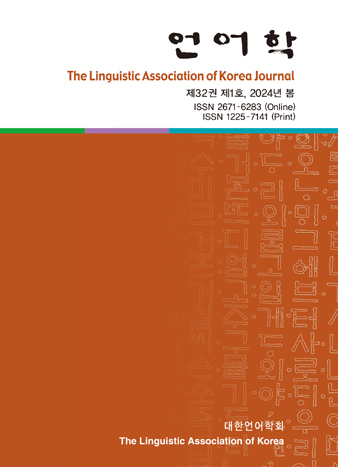대한언어학회 전자저널

32권 1호 (2024년 3월)
- 한국어와 영어의 차이에 따른 입력처리 교수가 한국 중학교 학습자들의 wh-의문문 습득에 미치는 영향
-
조우영
Pages : 49-71
Abstract
Cho, wooyoung. (2024). The effects of processing instruction on Korean middle school students' acquisition process of English wh-questions based on differences between L1 and L2. The Linguistic Association of Korea Journal, 32(1), 49-71. This paper explores how Korean learners acquire English wh-questions and which syntactic rules are involved, and whether Input Processing Instruction (PI) can facilitate Korean students' acquisition of English wh-questions. The acquisition patterns of English wh-questions by 50 middle school students were measured through Grammaticality Judgement Test (GJT), and PI lessons were given to 25 out of the 50 students in four 15-minutes for two weeks. The major findings of this experimental study are as follows: (1) Korean middle school students preferred subject wh-questions over object ones both in simple and embedded clauses, and sentence complexity such as embedding depth and preposition stranding greatly influenced their judgements. (2) PI was effective in that students improved significantly in GJT after short-term lessons. This study concludes that Korean middle school students have not yet fully acquired syntactic properties of English wh-questions and thus PI can benefit L2 learners in the early stage of interlanguage development.
Keywords
# wh의문문(wh-questions) # 입력처리교수법(Input Processing Instruction) # 구조적 거리(structural distance) # 문장 복잡성(sentence complexity) 제 2언어 습득(L2 acquisition)
References
- 김미사. (2019). EFL 환경에서 문법 유형에 따른 입력처리 교수의 효과 차이 영어 의문사와 관계대명사 학습을 바탕으로. 석사학위논문. 연세대학교 교육대학원.
- Kang, H.-S. (2013). Constraints on the Acquisition of English Constructions with Wh-movement by Korean Learners of English. M.A diss., The Graduate School Sookmyung Women\'s University.
- Lee, J.-H. (2009). A subject-object asymmetry in the comprehension of wh-questions by Korean learners of English. Applied linguistics, 31(1), 136-155.
- Chomsky, N. (1981). Lectures on Government and Binding. Dordrescht: Foris.
- Crain, S., & Thornton, R. (1991). Recharting the course of language acquisition: Studies in elicited production. In Biological and behavioral determinants of Language development, ed. N. Krasnegor, D. Rumbaugh, R. Schiefelbusch, and M. Studdert-Kennedy, 321-37. Hillsdale, N.J.: Erlbaum.
- de Villiers, J., Roeper, T., & Vainikka, A. (1990). The acquisition of long-distance rules. In Language processing and language acquisition, ed. L. Frazier and J. de Villiers, 257-97. Dordrecht: Kluwer.
- Hidebrand, J. (1987). The acquisition of preposition stranding. Canadian Journal of Linguistics, 32, 65-85.
- O\'Grady, W. (1998). Syntactic Development. University of Chicago Press.
- Stromswold, K. (1995). The acquisition of subject and object wh-questions. Language Acquisition, 4, 5-48.
- Tyack, D., & Ingram, D. (1977). Children\'s production and comprehension of questions. Journal of Child Language, 4, 211-24.
- Wilhelm, A., & Hanna, K. (1992). On the acquisition of Wh-questions. Calgary Working Papers in Linguistics. 15, 89-98.
- Yoshinaga, N. (1996). WH questions: A comparative Study of their Form and Acquisition in English and Japanese. Ph.D diss., University of Hawaii at Manoa.
- Thornton, R. (1990). Adventures in long-distance moving: The acquisition of complex wh-questions. Ph.D diss., The University of Conneticut.
- VanPatten, B. (2017). Situating instructed language acquisition: Facts about second language acquisition. Instructed Second Language Acquisition, 1, 92-109.